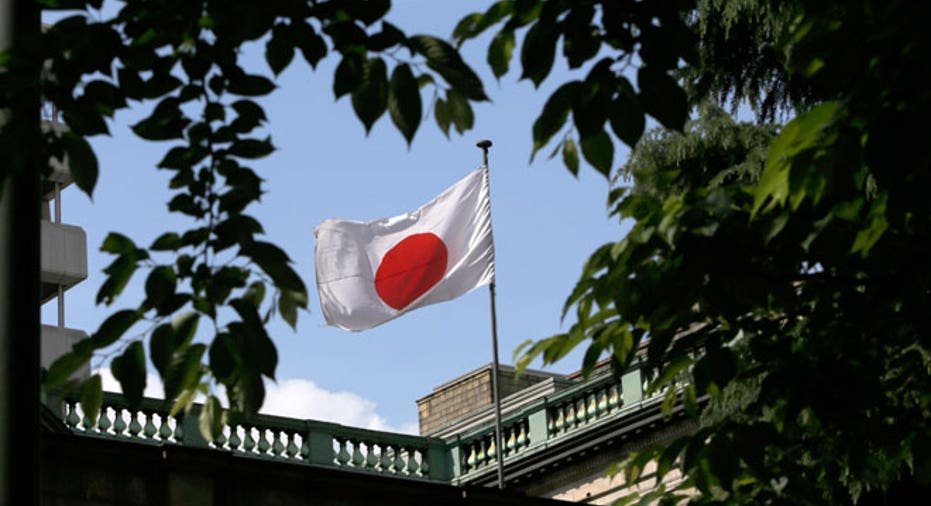Japan's Central Bank Maintains Policy

TOKYO – The Bank of Japan kept policy steady on Wednesday despite concerns over recent volatility in bond market, saying growth is starting to pick up even as risks loomed from an uncertain global outlook.
The central bank upgraded its assessment of the economy, saying it "has started picking up," as Prime Minister Shinzo Abe's programme of aggressive fiscal and monetary stimulus has boosted sentiment and a weaker yen has halted a decline in exports.
As expected, the central bank stuck with April's massive quantitative easing, in which it pledged to end 15 years of deflation by doubling its Japanese government-bond holdings in two years as it expands the supply of money at an annual pace of 60 trillion ($583 billion) to 70 trillion yen.
BOJ Governor Haruhiko Kuroda will hold a news conference from 0630 GMT with his comments expected to come out any time after 0715 GMT.
"I'm closely watching what Kuroda may have to say about recent volatility in JGBs," said Hideo Kumano, chief economist, Dai-ichi Life Research Institute and a former BOJ official.
"He has been saying that it would be natural for bond yields to rise gradually, but he may now need to warn against a sudden spike in yields, saying rapid rises are not desirable. He could also signal the need for the BOJ to become more proactive in conducting short-term market operations."
Despite the BOJ's enormous JGB purchases -- buying the equivalent of 70 percent of new government debt issuance -- bond prices have sold off recently, sending the 10-year yield to a one-year high of 0.92 percent last week as the BOJ's presence has dried up market liquidity.
"The BOJ is walking a very narrow path trying to engineer a gradual, not a sudden, rise in long-term rates backed by improvements in the economy," an official with knowledge of the central bank's thinking said before the policy board's two-day meeting.
Bond prices turned negative after the BOJ announcement on disappointment that the bank didn't address the market turbulence.
The benchmark 10-year yield was up 1.5 basis points to 0.895 percent, reversing an earlier fall to 0.865 percent in the morning session.
INFLATION DOUBTS
The BOJ unleashed the world's most intense burst of stimulus last month, promising to inject $1.4 trillion into the economy in less than two years to meet its pledge of achieving 2 percent inflation in roughly two years.
Doubts have emerged over whether that two-year time frame is realistic.
In the two-day BOJ meeting, board member Takahide Kiuchi proposed loosening the commitment by making its inflation target a medium- to long-term goal, and committing to intensive easing in the next two years. His proposal was rejected in an 8-1 vote.
Indeed, the BOJ may be stuck pursuing its massive monetary easing for up to five years before it stokes enough inflation to start unwinding its aggressive stimulus, a Reuters poll of BOJ watchers suggested Wednesday.
"At this point I don't see an exit for the BOJ," said former BOJ board member Nobuyuki Nakahara, one of the 10 economists and former BOJ officials surveyed. "Europe's economy is extremely weak. It is also possible that China's economy could slow suddenly."
The prospect of a long wait before the BOJ can begin tightening stands in stark contrast to expectations in global markets that the U.S. Federal Reserve could taper off its huge bond-buying campaign as early as this year.
The BOJ, by gobbling up JGBs, hopes to nudge Japanese investors out of the safety of bonds and into riskier assets like equities and to prod banks to lend money rather than parking it in bonds. But it is proving difficult to engineer a gentle rise in yields.
The rise in Tokyo shares to a 5-1/2-year high and improving business sentiment show that Abe's expansionary policies have generated more confidence.
BOJ officials say they would accept a natural rise in long-term interest rates that reflect prospects of an economic recovery and future inflation.
The pace of bond-price falls and the huge volatility -- including the biggest three-day jump in the benchmark 10-year yield since at least 2003 -- has made some central bankers nervous. But it wasn't enough to force a change in policy at the two-day meeting.
Market players polled by Reuters expect the JGB volatility to ease somewhat, with a median forecast for the 10-year yield of 0.800 percent at the end of this week.
Last week, in the midst of the market turbulence, the BOJ sought to cap the spike in yields by offering to inject 2.8 trillion yen into the Tokyo money market, more than three times the size usually offered in a single day.
If volatility persists, the BOJ may also consider increasing the amount of bonds it buys each month from the current 7.5 trillion yen until bond prices stabilise, sources say.
Japan's economy expanded at an annualised 3.5 percent in the first quarter, the fastest in a year, offering more evidence that Abe's sweeping stimulus is beginning to work.
But the gains remain tentative. Abenomics got a reality check on Wednesday, as April exports grew less than expected and imports surged on expensive energy imports, blowing out the trade deficit to the biggest April gap ever.
A sustained sharp rise in bond yields would hurt corporate capital spending, the soft spot of an otherwise more robust economy, and strain Japan's already tattered finances by boosting the cost of funding its huge debt pile.
"Business fixed investment continues to show resilience in non-manufacturing and appears to have stopped weakening on the whole," the BOJ said on Wednesday.



















